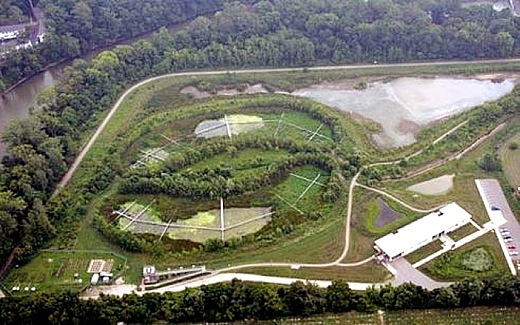SUBHEAD: Artificial wetlands could be affordable method of buffering agricultural runoff and restoring oceans.
By Derek Markham on 20 March 2012 for TreeHugger -
(http://www.treehugger.com/ocean-conservation/artificial-wetlands-could-be-affordable-method-buffering-agricultural-runoff.html)

Image above: Aerial view of artificial wetland in study. From original article.
The results of a 15 year study on manmade wetlands suggest that they may be a viable answer to buffering the effects of agricultural fertilizer runoff, which contribute to 'dead zones' in the ocean.
Researchers at Ohio State University created two artificial wetlands in 1994 to investigate whether or not they could replace natural wetlands which have been lost due to environmental degradation. One of the benefits of constructing these artificial wetlands was thought to be in cleaning and filtering polluted water, including mitigating the effects of excess fertilizer runoff, which has been contributing to hypoxic zones in the ocean.
.
By Derek Markham on 20 March 2012 for TreeHugger -
(http://www.treehugger.com/ocean-conservation/artificial-wetlands-could-be-affordable-method-buffering-agricultural-runoff.html)

Image above: Aerial view of artificial wetland in study. From original article.
The results of a 15 year study on manmade wetlands suggest that they may be a viable answer to buffering the effects of agricultural fertilizer runoff, which contribute to 'dead zones' in the ocean.
Researchers at Ohio State University created two artificial wetlands in 1994 to investigate whether or not they could replace natural wetlands which have been lost due to environmental degradation. One of the benefits of constructing these artificial wetlands was thought to be in cleaning and filtering polluted water, including mitigating the effects of excess fertilizer runoff, which has been contributing to hypoxic zones in the ocean.
"In the first wetland, Mitsch and his colleagues placed thirteen different types of plants. In the other one they let nature grow by itself, so they could see the difference between naturally grown plants and planted ones. After fifteen years of close inspection, it turned out the planted wetland had a taller plant community, but the unplanted wetland was more productive.
In two years, they ”…saw a pretty significant reduction in phosphorus and nitrate concentrations – close to the kind of decrease we typically see in a natural wetland.” Mitsch emphasizes that artificial wetlands can save money, since they require less investment in water purification systems. Still, while the American Midwest has lost 80 percent of its wetlands in the last two centuries, only 577,000 artificial wetlands have been created. According to Mitsch, 10 to 25 times that many are needed in the Mississippi in order to see a significant improvement in the Gulf’s situation." - NextNature (http://www.nextnature.net/2012/03/the-benefits-of-artificial-wetlands)According to the study, the wetlands also served as effective carbon sinks:
"The wetlands were effective carbon sinks with retention rates of 1800–2700 kilograms of carbon per hectare per year, higher than in comparable reference wetlands and more commonly studied boreal peatlands."The researchers also claimed that that creating the wetlands wasn't just effective, it was also fairly simple:
"It was a relatively simple, inexpensive way to create a wetland, and it worked.” - William Mitsch, director of the Olentangy River Wetland Research Park at Ohio State UniversityConsidering that in many areas, natural wetlands have decreased, creating these manmade buffers might be a possible answer to slowing the growth of dead zones, which is expected to increase with the effects of climate change.
.
No comments :
Post a Comment